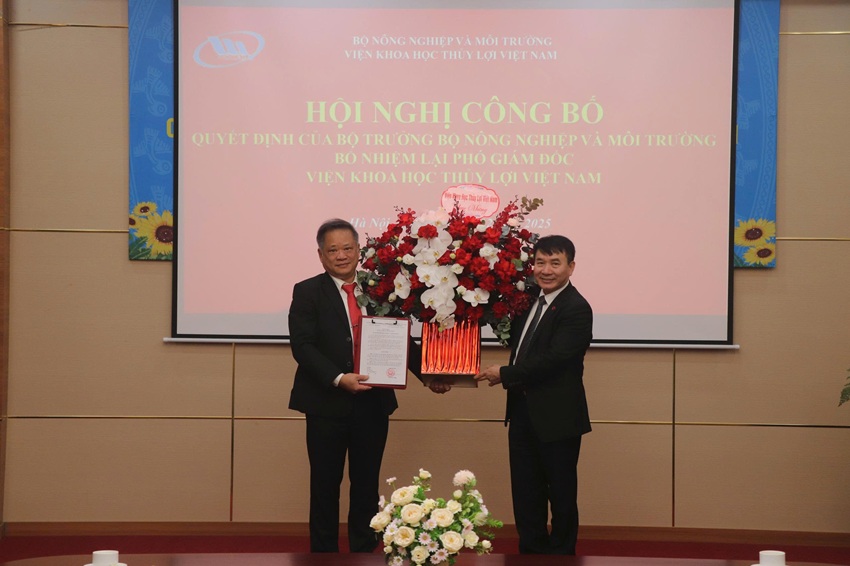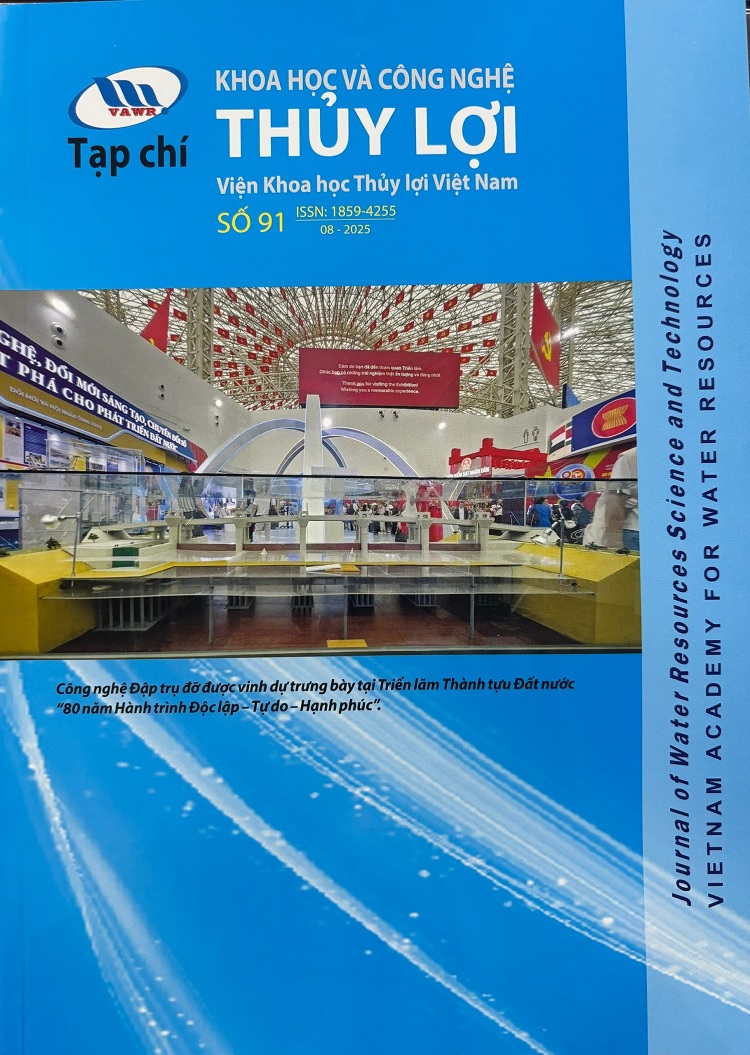Adapting to Climate-Change-Induced Drought Stress to Improve Water Management in Southeast Vietnam
08/04/2024Abstract:
In Southeast Vietnam, droughts have become more frequent, causing significant damage and impacting the region’s socio-economic development. Water shortages frequently affect the industrial and agricultural sectors in the area. This study aims to calculate the water balance and the resilience of existing water resource allocations in the La Nga-Luy River basin based on two scenarios: (1) business-as-usual and (2) following a sustainable development approach. The MIKE NAM and MIKE HYDRO BASIN models were used for rainfall–runoff (R-R) and water balance modeling, respectively, and the Keetch–Byram Drought Index (KBDI) was used to estimate the magnitude of the droughts. The results identified areas within the Nga-Luy River basin where abnormally dry and moderate drought conditions are common, as well as subbasins, i.e., in the southeast and northeast, where severe and extreme droughts often prevail. It was also shown that the water demand for the irrigation of the winter–spring and summer–autumn crop life cycles could be fully met under abnormally dry conditions. This possibility decreases to 85–100% during moderate droughts, however. In contrast, 65% and 45–50% of the water demand for irrigation is met for the winter–spring and summer–autumn crop life cycles, respectively, during severe and extreme droughts. Furthermore, this study demonstrates that the water demand for irrigation could still be met 100% and 75–80% of the time during moderate, and extreme or severe droughts, respectively,
through increased water use efficiency. This study could help managers to rationally regulate water in order to meet the agricultural sector’s needs in the region and reduce the damage and costs caused by droughts.
1. Introduction
2. Methodology
2.1. Study Area
2.2. Methodological Approach
2.3. MIKE HYDRO BASIN
2.4. Input Data for MIKE Models
2.5. Model Performance Evaluation
2.6. Scenarios Simulations
2.7. Quantifying the Magnitude of the Droughts
3. Results and Discussion
3.1. Model Calibration
3.2. Water Availability and Allocation under Climate Change
3.3. Water Balance of the La Nga and Luy River Basins
3.4. Drought Assessment and Prediction
3.4.1. Abnormally Dry Conditions
3.4.2. Moderate Drought Scenario
3.4.3. Severe Drought Scenario
3.4.4. Extreme Drought Scenario
3.5. Assessing the Response of the Irrigation System to Different Drought Scenarios
4. Conclusions
References
1. Costa, M.H.; Foley, J.A. Trends in the Hydrologic Cycle of the Amazon Basin. J. Geophys. Res. Atmos. 1999, 104, 14189–14198. [CrossRef]
2. Anand, J.; Gosain, A.K.; Khosa, R. Prediction of Land Use Changes Based on Land Change Modeler and Attribution of Changes in the Water Balance of Ganga Basin to Land Use Change Using the SWAT Model. Sci. Total Environ. 2018, 644, 503–519. [CrossRef] [PubMed]
3. Pereira, L.S.Water, Agriculture and Food: Challenges and Issues. Water Resour. Manag. 2017, 31, 2985–2999. [CrossRef]
4. Pham, H.; Olivier, P.A.Water Balance Changes in the Upper Part of Dong Nai River Basin. J. Vietnam. Environ. 2019, 11, 74–82. [CrossRef]
5. Walraevens, K.; Gebreyohannes Tewolde, T.; Amare, K.; Hussein, A.; Berhane, G.; Baert, R.; Ronsse, S.; Kebede, S.; Van Hulle, L.; Deckers, J.Water Balance Components for Sustainability Assessment of Groundwater-Dependent Agriculture: Example of the Mendae Plain (Tigray, Ethiopia). Land Degrad. Dev. 2015, 26, 725–736. [CrossRef]
6. Bao, Z.; Zhang, J.; Wang, G.; Chen, Q.; Guan, T.; Yan, X.; Liu, C.; Liu, J.; Wang, J. The Impact of Climate Variability and Land Use/Cover Change on the Water Balance in the Middle Yellow River Basin, China. J. Hydrol. 2019, 577, 123942. [CrossRef]
7. Deb, P.; Abbaszadeh, P.; Moradkhani, H. An Ensemble Data Assimilation Approach to Improve Farm-Scale Actual Evapotranspiration Estimation. Agric. For. Meteorol. 2022, 321, 108982. [CrossRef]
8. Saccon, P.Water for Agriculture, Irrigation Management. Appl. Soil Ecol. 2018, 123, 793–796. [CrossRef]
9. Batchelor, C.H.; Rama Mohan Rao, M.S.; Manohar Rao, S. Watershed Development: A Solution to Water Shortages in Semi-Arid India or Part of the Problem? Land Use Water Resour. Res. 2003, 3, 1–10.
10. Deb, P.; Moradkhani, H.; Han, X.; Abbaszadeh, P.; Xu, L. Assessing Irrigation Mitigating Drought Impacts on Crop Yields with an Integrated Modeling Framework. J. Hydrol. 2022, 609, 127760. [CrossRef]
11. Yoshida, K.; Azechi, I.; Hariya, R.; Tanaka, K.; Noda, K.; Oki, K.; Hongo, C.; Honma, K.; Maki, M.; Shirakawa, H. FutureWater Availability in the Asian Monsoon Region: A Case Study in Indonesia. J. Dev. Sustain. Agric. 2013, 8, 25–31.
12. UN Environment Programme. Vietnam Assessment Report on Climate Change; UNEP: Nairobi, Kenya, 2009.
13. Van Hong, N.; Nguyen, V.T. The Impact of Climate Change on the Transportation in Binh Thuan Province. Meteorol. Hydrol. J. 2021. (In Vietnamese) [CrossRef] [PubMed]
14. Vinh, P.Q.; H÷ìng, P.T.T. Assessing Agricultural Drought for Binh Thuan Province under Climate Change Scenario. Sci. Earth 2012, 34, 513–523.
15. Bastiaanssen,W.G.; Chandrapala, L.Water Balance Variability across Sri Lanka for Assessing Agricultural and Environmental Water Use. Agric. Water Manag. 2003, 58, 171–192. [CrossRef]
16. Golmohammadi, G.; Prasher, S.; Madani, A.; Rudra, R. Evaluating Three Hydrological DistributedWatershed Models: MIKE-SHE, APEX, SWAT. Hydrology 2014, 1, 20–39. [CrossRef]
17. Shi, P.; Chen, C.; Srinivasan, R.; Zhang, X.; Cai, T.; Fang, X.; Qu, S.; Chen, X.; Li, Q. Evaluating the SWAT Model for Hydrological Modeling in the Xixian Watershed and a Comparison with the XAJ Model. Water Resour. Manag. 2011, 25, 2595–2612. [CrossRef]
18. Suryatmojo, H.; Fujimoto, M.; Yamakawa, Y.; Kosugi, K.; Mizuyama, T.Water Balance Changes in the Tropical Rainforest with Intensive Forest Management System. Int. J. Sustain. Future Hum. Secur. J.-Sustain. 2013, 1, 56–62. [CrossRef]
19. Himanshu, S.K.; Pandey, A.; Shrestha, P. Application of SWAT in an Indian River Basin for Modeling Runoff, Sediment and Water Balance. Environ. Earth Sci. 2017, 76, 3. [CrossRef]
20. Marhaento, H.; Booij, M.J.; Rientjes, T.H.M.; Hoekstra, A.Y. Attribution of Changes in the Water Balance of a Tropical Catchment to Land Use Change Using the SWAT Model. Hydrol. Process. 2017, 31, 2029–2040. [CrossRef]
21. SANTOS, R.; FERNANDES, L.S.; CORTES, R.; PACHECO, F. Analysis of Hydrology andWater Allocation with Swat and Mike Hydro Basin in the Sabor River Basin, Portugal. WIT Trans. Ecol. Environ. 2018, 215, 347–355.
22. Uniyal, B.; Jha, M.K.; Verma, A.K. Assessing Climate Change Impact on Water Balance Components of a River Basin Using SWAT Model. Water Resour. Manag. 2015, 29, 4767–4785. [CrossRef]
23. Loliyana, V.D.; Patel, P.L. A Physics Based Distributed Integrated Hydrological Model in Prediction of Water Balance of a Semi-Arid Catchment in India. Environ. Model. Softw. 2020, 127, 104677. [CrossRef]
24. Singh, R.; Subramanian, K.; Refsgaard, J.C. Hydrological Modelling of a SmallWatershed Using MIKE SHE for Irrigation Planning. Agric. Water Manag. 1999, 41, 149–166. [CrossRef]
25. Usmanov, S.; Mitani, Y.; Kusuda, T. An Integrated Hydrological Model for Water Balance Estimation in the Chirchik River Basin, Northern Uzbekistan. Comput. Water Energy Environ. Eng. 2016, 5, 87. [CrossRef]
26. Makungo, R.; Odiyo, J.O.; Ndiritu, J.G.; Mwaka, B. Rainfall–Runoff Modelling Approach for Ungauged Catchments: A Case Study of Nzhelele River Sub-Quaternary Catchment. Phys. Chem. Earth Parts Abc 2010, 35, 596–607. [CrossRef]
27. Singh, A.; Singh, S.; Nema, A.K.; Singh, G.; Gangwar, A. Rainfall-Runoff Modeling Using MIKE 11 NAM Model for Vinayakpur Intercepted Catchment, Chhattisgarh. Indian J. Dryland Agric. Res. Dev. 2014, 29, 1–4. [CrossRef]
28. Hongsawong, P.; Sittichok, K. Runoff Estimation Using SWAT and MIKE HYDRO BASIN Models in the Pasak River Basin. Ph.D. Thesis, Kasetsart University, Bangkok, Thailand, 2021.
29. Husain, M.R.; Ishak, A.M.; Redzuan, N.; van Kalken, T.M.; Brown, K. Malaysian NationalWater Balance System (Nawabs) for Improved River Basin Management: Case Study in the Muda River Basin. In Proceedings of the E-Proceedings of the 37th IAHR World Congress, Kuala Lumpur, Malaysia, 13–18 August 2017; pp. 13–18.
30. Jha, M.K.; Gupta, A.D. Application of Mike Basin forWater Management Strategies in aWatershed. Water Int. 2003, 28, 27–35. [CrossRef]
31. Kolokytha, E.; Malamataris, D. Integrated Water Management Approach for Adaptation to Climate Change in Highly Water Stressed Basins. Water Resour. Manag. 2020, 34, 1173–1197. [CrossRef]
32. Yu, Y.; Disse, M.; Yu, R.; Yu, G.; Sun, L.; Huttner, P.; Rumbaur, C. Large-Scale Hydrological Modeling and Decision-Making for Agricultural Water Consumption and Allocation in the Main Stem Tarim River, China. Water 2015, 7, 2821–2839. [CrossRef]
33. DHI. MIKE HYDRO Basin User Guide; Danish Hydraulic Institute: Copenhagen, Denmark, 2017.
34. Bessa Santos, R.M.; Sanches Fernandes, L.F.; Vitor Cortes, R.M.; Leal Pacheco, F.A. Development of a Hydrologic and Water Allocation Model to AssessWater Availability in the Sabor River Basin (Portugal). Int. J. Environ. Res. Public. Health 2019, 16, 2419. [CrossRef]
35. Jaiswal, R.K.; Lohani, A.K.; Galkate, R.V. Decision Support for Scenario Analysis in a ComplexWater Resource Project. J. Appl. Water Eng. Res. 2021, 9, 52–68. [CrossRef]
36. Allen, R.G. An Update for the Calculation of Reference Evapotranspiration. ICID Bull. 1994, 43, 35–92.
37. Allen, R.G.; Smith, M.; Perrier, A.; Pereira, L.S. An Update for the Definition of Reference Evapotranspiration. ICID Bull. 1994, 43, 1–34.
38. Penman, H.L. Natural Evaporation from Open Water, Bare Soil and Grass. Proc. R. Soc. Lond. Ser. Math. Phys. Sci. 1948, 193, 120–145.
39. Allen, R.G.; Pereira, L.S.; Raes, D.; Smith, M. Crop Evapotranspiration-Guidelines for Computing Crop Water Requirements-FAO Irrigation and Drainage Paper 56. Fao Rome 1998, 300, D05109.
40. Jabbari, A.; Bae, D.-H. Application of Artificial Neural Networks for Accuracy Enhancements of Real-Time Flood Forecasting in the Imjin Basin. Water 2018, 10, 1626. [CrossRef]
41. Chicco, D.; Warrens, M.J.; Jurman, G. The Coefficient of Determination R-Squared Is More Informative than SMAPE, MAE, MAPE, MSE and RMSE in Regression Analysis Evaluation. PeerJ Comput. Sci. 2021, 7, e623. [CrossRef] [PubMed]
42. Deb, P.; Moradkhani, H.; Abbaszadeh, P.; Kiem, A.S.; Engström, J.; Keellings, D.; Sharma, A. Causes of the Widespread 2019–2020 Australian Bushfire Season. Earths Future 2020, 8, e2020EF001671. [CrossRef]
43. Keetch, J.J.; Byram, G.M. A Drought Index for Forest Fire Control; US Department of Agriculture, Forest Service, Southeastern Forest Experiment Station: Asheville, NC, USA, 1968; Volume 38.
44. Mallya, G.; Zhao, L.; Song, X.C.; Niyogi, D.; Govindaraju, R.S. 2012 Midwest Drought in the United States. J. Hydrol. Eng. 2013, 18, 737–745. [CrossRef]
45. Svoboda, M.; LeComte, D.; Hayes, M.; Heim, R.; Gleason, K.; Angel, J.; Rippey, B.; Tinker, R.; Palecki, M.; Stooksbury, D. The Drought Monitor. Bull. Am. Meteorol. Soc. 2002, 83, 1181–1190. [CrossRef]
46. Zink, M.; Samaniego, L.; Kumar, R.; Thober, S.; Mai, J.; Schäfer, D.; Marx, A. The German Drought Monitor. Environ. Res. Lett. 2016, 11, 074002. [CrossRef]
47. Hosoya, Y.; Takeuchi,W. Performance of Drought Monitoring Methods towards Rice Yield Estimation in Greater Mekong Sub-Region (GMS). In Proceedings of the 33rd Asian Conference on Remote Sensing (ACRS), Patthaya, Thailand, 26–30 November 2012; Volume 28.
48. Shofiyati, R.; Takeuchi, W.; Sofan, P.; Darmawan, S.; Supriatna, W. Indonesian Drought Monitoring from Space. A Report of SAFE Activity: Assessment of Drought Impact on Rice Production in Indonesia by Satellite Remote Sensing and Dissemination with Web-GIS. In IOP Conference Series: Earth and Environmental Science, Proceedings of the 7th IGRSM International Remote Sensing & GIS Conference and Exhibition, Kuala Lumpur, Malaysia, 22–23 April 2014; IOP Publishing: Bristol, UK, 2014; Volume 20, p. 012048.
49. Thang, N.V.; Khiem, M.V.; Takeuchi, W.; An, V.N. Research and Propose a Real-Time Drought Monitoring System in Vietnam. In Meteorol. Hydrol. J.; 2014. Available online: https://cesti.gov.vn/bai-viet/khcn-trong-nuoc/nghien-cuu-de-xuat-he-thong-giamsat-han-han-thoi-gian-thuc-o-viet-nam-01004367-0000-0000-0000-000000000000 (accessed on 20 April 2023). (In Vietnamese)
50. Thuc, T.; Thang, N.V.; Cuong, H.D.; Khiem, M.V.; Mau, N.D.; Thang, V.V.; Takeuchi, W.; An, V.N. The Applicability of the Keetch-Byram Drought Index (KBDI) in Drought Monitoring in Vietnam. In Proceedings of the Interdisciplinary Scientific Conference on Task Groups Under the Central Highlands Program 3, Tay Nguyen, Vietnam, 29–30 November 2013; p. 177. (In Vietnamese).
51. Quyen, T.N.N.; Liem, D.N.; Nguong, D.N.; Thoang, N.; Long, T.B.; Loi, K.N. Drought Zoning Based on Drought Index and Hydrological Simulation in Srepok Basin in the Central Highlands. VNU J. Sci. Earth Environ. Sci. 2017. Available online: https://www.researchgate.net/publication/315718728_Phan_vung_han_han_dua_tren_chi_so_han_va_mo_phong_che_do_thuy_van_tren_luu_vuc_Srepok_vung_Tay_Nguyen_
Zoning_Drought_Reply_on_Drought_Index_and_Simulation_Hydrological_Regime_in_Srepok_Watershed_Tay_N (accessed on 20 April 2023). (In Vietnamese).
52. Moges, E.; Demissie, Y.; Larsen, L.; Yassin, F. Sources of Hydrological Model Uncertainties and Advances in Their Analysis. Water 2021, 13, 28. [CrossRef]
53. Renard, B.; Kavetski, D.; Kuczera, G.; Thyer, M.; Franks, S.W. Understanding Predictive Uncertainty in Hydrologic Modeling: The Challenge of Identifying Input and Structural Errors. Water Resour. Res. 2010, 46, 527. [CrossRef]
54. Brigode, P.; Oudin, L.; Perrin, C. Hydrological Model Parameter Instability: A Source of Additional Uncertainty in Estimating the Hydrological Impacts of Climate Change? J. Hydrol. 2013, 476, 410–425. [CrossRef]
55. Deser, C.; Knutti, R.; Solomon, S.; Phillips, A.S. Communication of the Role of Natural Variability in Future North American Climate. Nat. Clim. Change 2012, 2, 775–779. [CrossRef]
——————————————————————————————————————
► See detail: Adapting to Climate-Change-Induced Drought Stress to Improve Water Management in Southeast Vietnam
Phong Nguyen Thanh 1,2, Thinh Le Van 3, Tuan Tran Minh 3, Tuyen Huynh Ngoc 3, Worapong Lohpaisankrit 4 ,
Quoc Bao Pham 5 , Alexandre S. Gagnon 6 , Proloy Deb 7 , Nhat Truong Pham 8, Duong Tran Anh 1,2
and Vuong Nguyen Dinh 3,*
1 Laboratory of Environmental Sciences and Climate Change, Institute for Computational
Science and Artificial Intelligence, Van Lang University, Ho Chi Minh City 700000, Vietnam;
phong.nguyenthanh@vlu.edu.vn (P.N.T.); duong.trananh@vlu.edu.vn (D.T.A.)
2 Faculty of Environment, School of Technology, Van Lang University, Ho Chi Minh City 700000, Vietnam
3 Southern Institute of Water Resources Research, Ho Chi Minh City 700000, Vietnam; lethinh912@gmail.com (T.L.V.);
tranminhtuan04@gmail.com (T.T.M.); ngoctuyen42n@gmail.com (T.H.N.)
4 Department of Civil Engineering, Faculty of Engineering, Khon Kaen University, Khon Kaen 40002, Thailand;
woralo@kku.ac.th
5 Faculty of Natural Sciences, Institute of Earth Sciences, University of Silesia in Katowice, B˛edzi ´nska Street 60,
41-200 Sosnowiec, Poland; quoc_bao.pham@us.edu.pl
6 School of Biological and Environmental Science, Liverpool John Moores University, Liverpool L3 3AF, UK;
a.gagnon@ljmu.ac.uk
7 International Rice Research Institute (IRRI), NASC Complex, Dev Prakash Shastri Marg, Pusa,
New Delhi 110012, India; debproloy@gmail.com
8 Computational Biology and Bioinformatics Laboratory, Department of Integrative Biotechnology,
College of Biotechnology and Bioengineering, Sungkyunkwan University, Suwon 16419, Gyeonggi-do,
Republic of Korea; truongpham96@skku.edu
* Correspondence: dinhvuongkhtlmn@gmail.com
Sustainability 2023, 15, 9021 https://www.mdpi.com/journal/sustainability
Ý kiến góp ý:









